(VOVworld) - The Koreans love their traditional costume Hanbok just as the Vietnamese love Ao Dai. Hanbok appears at weddings, funerals, folk festivals, special anniversaries and many other Korean events. The term Hanbok means "Korean clothing". One Korean phrase regarding the shape of the outfit is 'upper is narrow, lower is wide'. Today we talk with Park Nark-jong, Director of Korean Cultural Center in Vietnam, about Korean outfits.
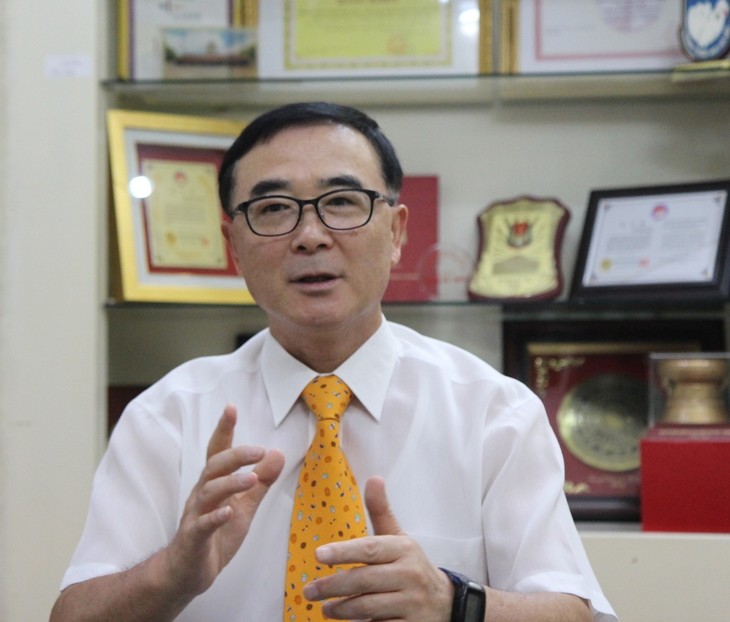
Park Nark-jong, Director of Korean Cultural Center in Vietnam
|
Could you tell me something about history of Hanbok ?
It can be said that the oldest evidence of early Hanbok can still be seen on the frescoes from the Kyuki-do period, about 300 BC. However, the most common image of Hanbok that everyone sees today was created and fixed during the reign of the Joseon Dynasty, over 1600 years ago. This was the period in which the concept of one’s social class in the society was rather strict, under the influence of Confucian thought. Hanbok, therefore, was used to distinguish different levels of the social strata. For example, there were the kings, mandarins, and civilians. Each class was also divided into a hierarchy of male and female. That’s why the Hanbok outfits that appeared during this period were very diverse so that it could express one’s social class.
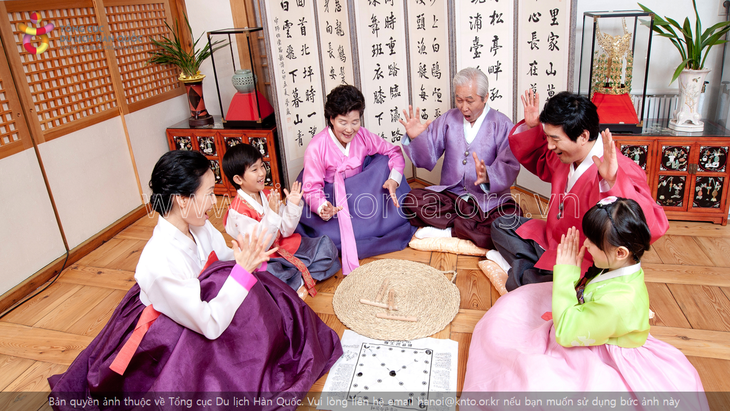
A family wearing Hanbok. (Photo: www.visitkorea.org.vn)
|
Which types of fabrics are traditional Korean costumes made from ?
Fabrics used to sew Hanbok were quite diverse. In the past, Koreans used silk to sew the vestment lines. For everyday-wear, the Koreans used hemp or linen. Today we use many synthetic materials to tailor the modern form of Hanbok.
What are the typical colors of Hanbok?
There is a variety of colors scheme used to make a Hanbok outfit. In ancient times, particularly, during the Joseon Dynasty, civilians were banned from using yellow to sew Hanbok as it was only reserved for the King. The concept of one’s destiny and social class discrimination no longer exists in today’s society, so everyone can freely select fabric colors or use a combination of colors to make their outfit, depending on one’s interests, personality or fashion trend. There is no restriction on the choice of colors used to make the Hanbok.
They are usually made in a blend of colorful designs. Short jackets for women always include bright yellow, burgundy or turquoise with wide sleeved skirts in navy. Hanboks for men are usually made in white, black and blue.
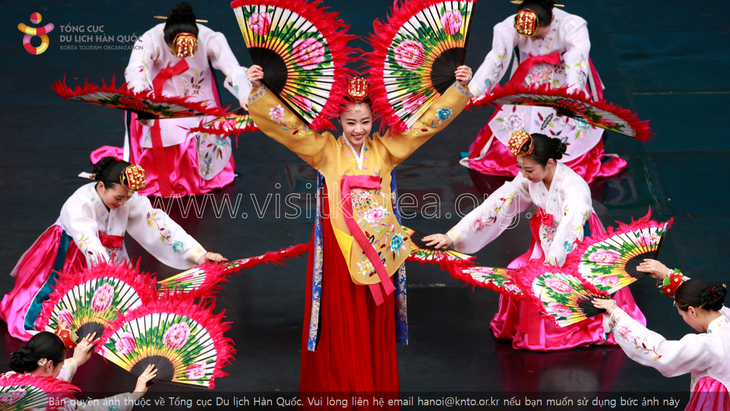
Hanbok in art performance. (Photo: www.visitkorea.org.vn)
|
How a traditional Hanbok is tailored?
In the past, when garment and textiles technology had not yet been developed, all the fabrics were woven by hand. Silks or linens were woven from cotton fibers then stitched into the fabric. Decorative patterns and the quality of the fabric vary according to one’s occupation. Outfits for mandarins will be made from beautiful high- quality flower-print-silks while outfits for civilians lack any flower-print patterns. There are sophisticated Hanboks to wear to special events and simple ones to wear in daily life. Kings or mandarins have their own Hanbok artisans to sew outfits for them. As for civilians, it’s their mothers or the woman in the family who directly sew for them.

Small bags to accompany Hanbok. (Photo: www.visitkorea.org.vn)
|
How was social class reflected through Hanbok?
It’s the rule of colors for each Hanbok. Mandarins wore blue violet or purple with a Samo hat. Hanboks for civilians were made from white or milk white cloths.
On what occasions do Koreans wear Hanbok ?
The Hanbok varies according to different circumstances. For those who work or have a job that is an important and/ or of formal nature, they have a specific outfit. For a wedding, there will be a special Hanbok. For a funeral, there will be one for mourning and when Koreans hold ancestor sacrifices, they wear a ceremonial Hanbok. It depends on the purpose of events that Koreans attend. In the past, Koreans wore the outfit as daily clothing but today, a traditional Hanbok is reserved for special occasions like the traditional lunar new year or for wedding ceremonies. Recently, a modern version of the Hanbok has received lots of attention from people, especially young people who love to use it as a street outfit.
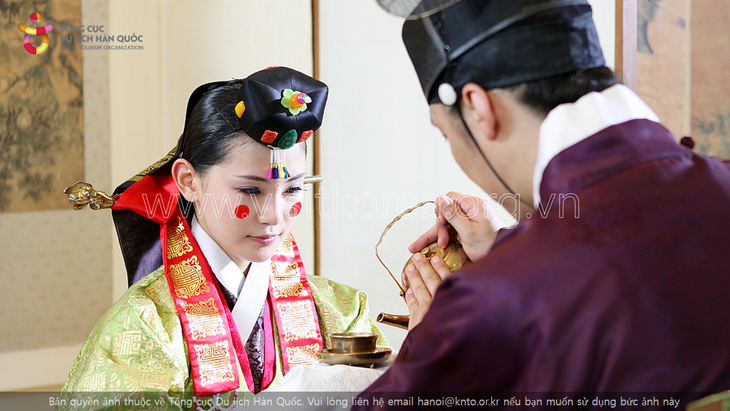
Wedding Hanbok. (Photo: www.visitkorea.org.vn)
|
Is there anything to pay attention to when wearing a Hanbok ?
One thing to note is that since a Hanbok for women consists of many components like short tightly fitting jacket for the upper body, baggy pants inside, wide sleeves skirt and long jacket outside. So when wearing Hanbok for women, we really have to pay attention to the order, for example, what to wear first, what to wear last. We also need to pay attention to folding the shape of a Hanbok, so that it can glorify the beauty of the wearer. A long jacket for Hanbok is often used when we go out.
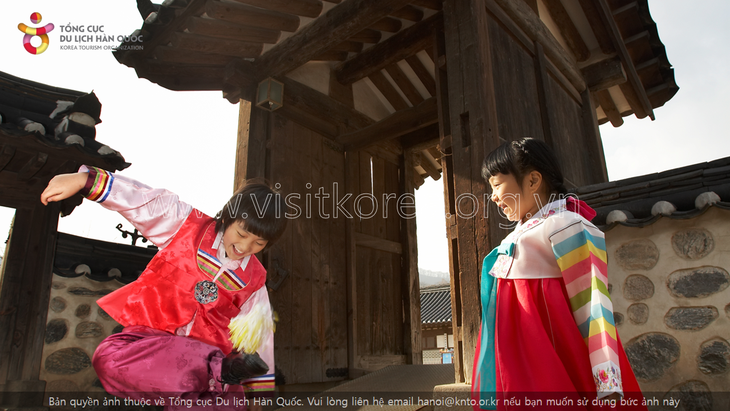
Hanbok for children. (Photo: www.visitkorea.org.vn)
|
What are the differences between male and female outfits?
One thing that we can easily recognize about the male and female Hanbok is that for men, the traditional Hanbok has less complicated seams and decorative patterns in comparison to female Hanbok. In general, male outfits focus on simplicity and convenience. For women, there are many more of cloth, with 6 different types of seams including the inside pronged seams to make Hanbok socks.

Male and female Hanbok outfits. (Photo: www.visitkorea.org.vn)
|
Could you name some of accessories to go with a Hanbok ?
As is seen in many Korean movies, Korean people have an adult ceremony for both the male and female. For girls, prior to their adult ceremony, they always braid their hair and only drop their hair when wearing a traditional Hanbok. After the adult ceremony, a woman has the right to bun up their hair, so a hairpin become a very important accessory to accompany a Hanbok. A woman also always wear a norigae pendant to decorate her outfit. They can also carry a Hanbok bag which is quite small, just to fit in coins. The bag is a decorative item which adds more to the beauty of the outfit. Socks that go with a Hanbok have a very special tapered shape, compared to normal socks. Socks which are tapered must go with rubber shoes which also have the tapered and upturned shape. Both men and women wear the same type of shoes.
The Hanbok looks gorgeous on both men and women. I would love to have opportunity to wear a Hanbok in the near future. Thank you Mr. Park Nark-jong for sharing with us some interesting facts about the Hanbok- the traditional costume of Koreans. That’s been Culture Rendezvous and good bye until next time !